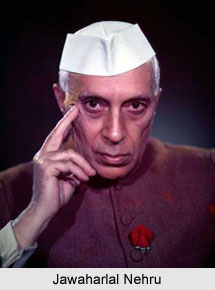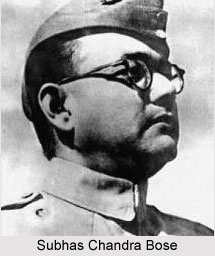 Indian Independence League was a political organisation active from 1920s to 1940s. Indian Independence League was established with the aim of unifying the residents who lived outside India, in order to remove India from the British colonial rule. The organisation was established in 1928 by praiseworthy Indian nationalists like- Subhas Chandra Bose and Jawaharlal Nehru. Initially the establishment was founded in various parts of South-East Asia, and included Indian expats. Later, the group also encompassed Indian nationalists in banishment under Japanese line of work, following Japan`s successful Malayan Campaign during the initial period of the Second World War. The Japanese encouraged Indians in Malaya during the Japanese Occupation to join the Indian Independence League.
Indian Independence League was a political organisation active from 1920s to 1940s. Indian Independence League was established with the aim of unifying the residents who lived outside India, in order to remove India from the British colonial rule. The organisation was established in 1928 by praiseworthy Indian nationalists like- Subhas Chandra Bose and Jawaharlal Nehru. Initially the establishment was founded in various parts of South-East Asia, and included Indian expats. Later, the group also encompassed Indian nationalists in banishment under Japanese line of work, following Japan`s successful Malayan Campaign during the initial period of the Second World War. The Japanese encouraged Indians in Malaya during the Japanese Occupation to join the Indian Independence League.
Indian Independence League initially was founded to nurture Indian Nationalism and to receive Japanese support for the Indian Independence Movement. IIL interacted and commanded the first Indian National Army under Mohan Singh, before its breaking up. The League came under the headship of Subhas Chandra Bose after he arrived in South-East Asia. As Japan occupied South-East Asia, a large number of expatriate Indian population came under Japanese occupancy. Even before the war arrived at Malaya, a framework of local Indian associations had survived. The largest part of the local Indian associations possessed the likes of the pre-war Central Indian Association, the Singapore Indian Independence league and other organisations. K.P.K. Menon, Nedyam Raghavan, Pritam Singh, S.C. Goho and others were the prestigious members of these organisations. These groups started joining the local Indian Independence leagues. Thus they became the prevailing intermediating organisation between the local Indian population and the Japanese occupation force.
Indian Independence League also provided security and perquisites to its members. A card holder of the League could smoothly purchase a railway ticket. With the IIL card people used to buy products like toothpaste and soap at reasonable prices from the headquarters. Rations were also issued to them after producing the card. Members of the Indian Independence League also could send and receive letters to hard-to-reach places, like Ceylon, as they used to work with the Swiss Red Cross.
Another noted member of the Indian Independence League, Rash Behari Bose fled to Japan. He was a praiseworthy Indian revolutionary who fetched the attention of the British Government due to his involvement in the Delhi-Lahore conspiracy of 1912. He has proposed the plan to assassinate the then Viceroy, Lord Hardinge. British government also kept eyes on him due to his active involvement in the Ghadr Conspiracy of 1915. After fleeing to Japan he married a Japanese woman and became a naturalised Japanese citizen. Rash Behari Bose tried his utmost to interest Japanese efforts to upgrade quality of the Indian Independence movement. After being convinced by the reports from Fujiwara and the validation of the local Independence leagues, the Imperial General Headquarters asked Rash Behari Bose to help in expanding and commixing the Indian movement that was taking shape at that time. On his advice, the Imperial General Headquarters attached the developing INA to a political organisation. They also spoke out for the civilian Indian population in South-east Asia.
On March 1942 Rash Behari Bose invited the local leaders of the Indian Independence leagues to a conference that took place in Tokyo. But the Tokyo conference eventually failed to reach to any concrete decisions. Rash Behari faced a number of differences from many Indian delegations. They attempted to attack Rash Behari due to his long association with Japan. But in the conference it was decided that they would again meet in Bangkok. The Indian delegation returned to Singapore with Rash Behari in April.
 Rash Behari Bose was invited to chair a public meeting in Singapore. The public meeting experienced the declaration of the All-Malayan Indian Independence League under the headship of Nedyam Raghavan, a Penang Barrister and a prominent Malayan Indian. K.P.K. Menon and S.C Goho, the latter, chairman of the Singapore Indian Independence League, formed the governing body. A number of proposals were made at the meeting, which included- institution of a Council of Action as the executive arm, establishment of a body which the regional leagues would report to, relations between INA and the council and those between the council and the Japanese authority.
Rash Behari Bose was invited to chair a public meeting in Singapore. The public meeting experienced the declaration of the All-Malayan Indian Independence League under the headship of Nedyam Raghavan, a Penang Barrister and a prominent Malayan Indian. K.P.K. Menon and S.C Goho, the latter, chairman of the Singapore Indian Independence League, formed the governing body. A number of proposals were made at the meeting, which included- institution of a Council of Action as the executive arm, establishment of a body which the regional leagues would report to, relations between INA and the council and those between the council and the Japanese authority.
Decisions were taken to vote on these propositions by a delegacy larger than that had met at Tokyo, and meeting elsewhere rather than on Japanese ground. There also remained proffers that members of the League, including Niranjan Singh Gill who directed the PoW camps, were worried about Japanese designs concerning the league and the Independence movement. However Indian Independence League earned support from the Indian population. By the end of August, membership of the League was estimated at hundred-thousand. Membership of the League proved to be beneficial. In the middle of war-time emergency, body of the League had proved to be advantageous while dealing with the occupation authorities. It also served as an identity proof. Ration was also issued by producing the membership card.
The Bangkok conference took place in June 1942. The conference witnessed the constitution of the Indian Independence League. The league had a Council for Action and a Committee of representatives under it. The territorial and local branches of IIL were under the Committee of representatives. The chairperson of the council was Rash Behari Bose. Other key members like K.P.K Menon, Nedyam Raghavan became the civilian members of the counil. The committee of representatives consisted of members from 12 territories with Indian population, with delegacy relative to the representative Indian population. It was also decided in the conference that the Indian National Army would be subordinate to it.
A thirty-four point resolution was also taken in the Bangkok conference. It was expected by the Indian Independence League that the Japanese government would respond favourably to these points. This thirty-four point resolution involves the demand that `the Japanese government clearly, explicitly and publicly recognise India as an independent nation and the league as the nation`s representatives and guardians`.
Other points under the thirty-four point resolution also called for assurances from the Japanese on Free India`s relation with Japan. According to this thirty-four point resolution it was mentioned that Japan should respect the sovereignty and territorial integrity of India. It was also demanded from Japan that they should clearly and unambiguously commit themselves before the league went forward any further in collaboration. It was also demanded under the resolution that the Indian National Army should be harmonised, bearing the status of an allied army and be treated as such. It was also asked that all Indian PoWs should be released to the INA. Under the thirty-four point resolution it was asked for that the Japanese must help the army with loans, and would not ask it to utilise it in any other purpose besides the freeing of India. The thirty-four point resolution was punctually sent on to what was then the Japanese intermediating office, the Iwakuro Kikan.
In 1945, noted Indian community leader Pritam Singh took active part in both the Indian Independence League and also Indonesia`s struggle for independence in Jakarta. The Centre brought in the Swathantra Sainik Samman Pension Scheme in 1972. This enabled the freedom fighters too, to receive pension. However the strategy faced substantial resistance to enforce the scheme. For example, it took nearly 24 years of legal battle for S. M. Shanmugam to ultimately receive his pension in August 2006.
Later on, the Indian Independence League experienced a prominent role in film maker K. A. Devarajan`s film "Gopuram", released in 1998. The film portrayed that the maternal grandfather of an Indian journalist was a freedom fighter during 1930s in Japan, who was wanted by the British police. After an unspecified period of time, the grandfather joined the Indian Independence League in Japan and his efforts were well presented. In Amitav Ghosh`s novel The Glass Palace (published in 2000), Ghosh accounts the story of fictional Rangoon teak trade fortunes of Rajkumar Raha and his extended family. In the book, it was shown that Uma Dey is a widow and an Indian Independence League activist. The rest of the novel uses her appearance to shocase post-colonial divisions.



















